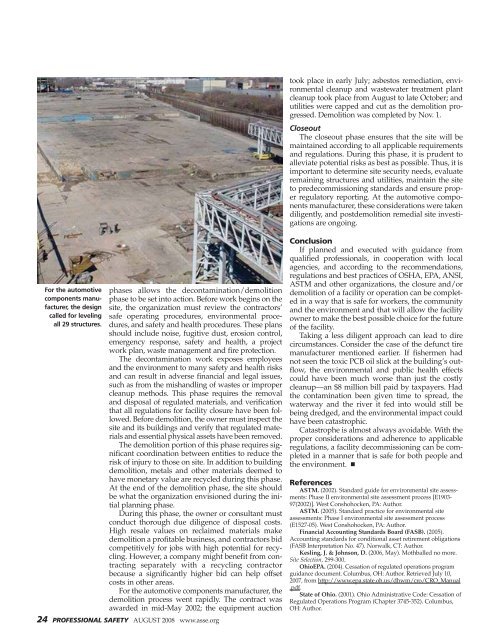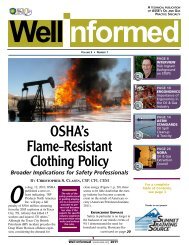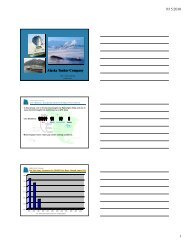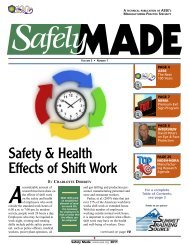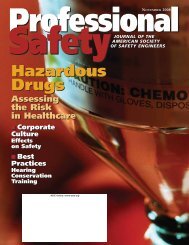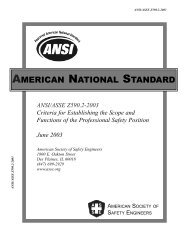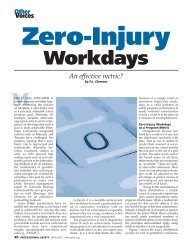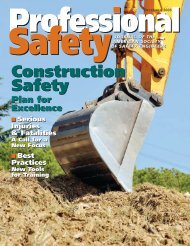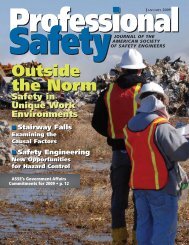Safety 2008 - ASSE - American Society of Safety Engineers
Safety 2008 - ASSE - American Society of Safety Engineers
Safety 2008 - ASSE - American Society of Safety Engineers
Create successful ePaper yourself
Turn your PDF publications into a flip-book with our unique Google optimized e-Paper software.
took place in early July; asbestos remediation, environmentalcleanup and wastewater treatment plantcleanup took place from August to late October; andutilities were capped and cut as the demolition progressed.Demolition was completed by Nov. 1.CloseoutThe closeout phase ensures that the site will bemaintained according to all applicable requirementsand regulations. During this phase, it is prudent toalleviate potential risks as best as possible. Thus, it isimportant to determine site security needs, evaluateremaining structures and utilities, maintain the siteto predecommissioning standards and ensure properregulatory reporting. At the automotive componentsmanufacturer, these considerations were takendiligently, and postdemolition remedial site investigationsare ongoing.For the automotivecomponents manufacturer,the designcalled for levelingall 29 structures.phases allows the decontamination/demolitionphase to be set into action. Before work begins on thesite, the organization must review the contractors’safe operating procedures, environmental procedures,and safety and health procedures. These plansshould include noise, fugitive dust, erosion control,emergency response, safety and health, a projectwork plan, waste management and fire protection.The decontamination work exposes employeesand the environment to many safety and health risksand can result in adverse financial and legal issues,such as from the mishandling <strong>of</strong> wastes or impropercleanup methods. This phase requires the removaland disposal <strong>of</strong> regulated materials, and verificationthat all regulations for facility closure have been followed.Before demolition, the owner must inspect thesite and its buildings and verify that regulated materialsand essential physical assets have been removed.The demolition portion <strong>of</strong> this phase requires significantcoordination between entities to reduce therisk <strong>of</strong> injury to those on site. In addition to buildingdemolition, metals and other materials deemed tohave monetary value are recycled during this phase.At the end <strong>of</strong> the demolition phase, the site shouldbe what the organization envisioned during the initialplanning phase.During this phase, the owner or consultant mustconduct thorough due diligence <strong>of</strong> disposal costs.High resale values on reclaimed materials makedemolition a pr<strong>of</strong>itable business, and contractors bidcompetitively for jobs with high potential for recycling.However, a company might benefit from contractingseparately with a recycling contractorbecause a significantly higher bid can help <strong>of</strong>fsetcosts in other areas.For the automotive components manufacturer, thedemolition process went rapidly. The contract wasawarded in mid-May 2002; the equipment auction24 PROFESSIONAL SAFETY AUGUST <strong>2008</strong> www.asse.orgConclusionIf planned and executed with guidance fromqualified pr<strong>of</strong>essionals, in cooperation with localagencies, and according to the recommendations,regulations and best practices <strong>of</strong> OSHA, EPA, ANSI,ASTM and other organizations, the closure and/ordemolition <strong>of</strong> a facility or operation can be completedin a way that is safe for workers, the communityand the environment and that will allow the facilityowner to make the best possible choice for the future<strong>of</strong> the facility.Taking a less diligent approach can lead to direcircumstances. Consider the case <strong>of</strong> the defunct tiremanufacturer mentioned earlier. If fishermen hadnot seen the toxic PCB oil slick at the building’s outflow,the environmental and public health effectscould have been much worse than just the costlycleanup—an $8 million bill paid by taxpayers. Hadthe contamination been given time to spread, thewaterway and the river it fed into would still bebeing dredged, and the environmental impact couldhave been catastrophic.Catastrophe is almost always avoidable. With theproper considerations and adherence to applicableregulations, a facility decommissioning can be completedin a manner that is safe for both people andthe environment. ReferencesASTM. (2002). Standard guide for environmental site assessments:Phase II environmental site assessment process [E1903-97(2002)]. West Conshohocken, PA: Author.ASTM. (2005). Standard practice for environmental siteassessments: Phase I environmental site assessment process(E1527-05). West Conshohocken, PA: Author.Financial Accounting Standards Board (FASB). (2005).Accounting standards for conditional asset retirement obligations(FASB Interpretation No. 47). Norwalk, CT: Author.Kesling, J. & Johnson, D. (2006, May). Mothballed no more.Site Selection, 299-300.OhioEPA. (2004). Cessation <strong>of</strong> regulated operations programguidance document. Columbus, OH: Author. Retrieved July 10,2007, from http://www.epa.state.oh.us/dhwm/cro/CRO_Manual.pdf.State <strong>of</strong> Ohio. (2001). Ohio Administrative Code: Cessation <strong>of</strong>Regulated Operations Program (Chapter 3745-352). Columbus,OH: Author.


